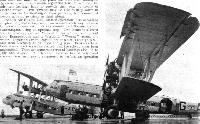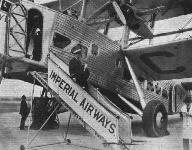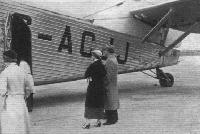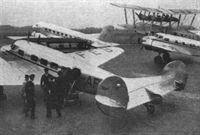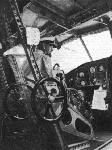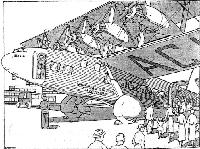
Варианты
Short S.17 Kent и L.17 Scylla
<...>
Компанией "Imperial Airways" в начале 1933 года был заказан сухопутный вариант, построены два самолета. Их обозначили L.17, машины совершили первые полеты в марте и мае 1934 года. Чуть позднее их назвали "Scylla" и "Syrinx". Самолеты оснащались четырьмя двигателями XFBM мощностью 595 л. с., вмещали 39 пассажиров и имели автопилоты. Позднее один самолет использовался для испытания двигателей Perseus IIL, а после повреждения и восстановления - в испытании двигателей Pegasus XC мощностью 660 л.с. Оба самолета были выведены из эксплуатации в 1940 году.
Описание:
- Short S.17 Kent и L.17 Scylla
- Flight, April 1934
THE SHORT "SCYLLA”
Фотографии
-
Aeroplane Monthly 1984-10 / J.Stroud - Wings of Peace
Регистрационный номер: G-ACJJ [28] Scylla having the wheel chocks removed before leaving Croydon on its inaugural flight to Le Bourget on May 16, 1934. Note the Civil Air Ensign.
-
Мировая Авиация 234
Регистрационный номер: G-ACJJ [28] Кабина L.17 имела ширину 3,4 м, что обеспечивало новый уровень комфорта во время путешествия (включая систему вентиляции свежим воздухом).
-
Aeroplane Monthly 1984-10 / J.Stroud - Wings of Peace
Регистрационный номер: G-ACJJ [28] An early picture of Scylla taken at Croydon. Note the height of the tailplane from the ground.
-
Flight 1934-11 / Flight
Регистрационный номер: G-ACJJ [28] -
Aeroplane Monthly 1989-10 / Personal album. Civil
Регистрационный номер: G-ACJJ [28] Close-up detail of the four 550 h.p. Bristol Jupiter XFBM radial engines of the Short L.17 Scylla G-ACJJ. Interestingly, G-ACJJ does not have Imperial Airways London painted beneath the two forward windows. An additional window seems to have been added just forward of the A in the registration letters, normally a recognition feature of the second L.17, Syrinx, after its rebuild.
-
Air-Britain Archive 1981-02
Регистрационный номер: G-ACJJ [28] One of only two Short L.17s built, "Scylla" served with NAC and was about to be impressed when it was overturned by a gale at Drem 14.4.40 and written off. Date and location of this photo are unknown - any offers?
-
Flight 1934-04 / Flight
Регистрационный номер: G-ACJJ [28] TOWERING: With tail on the ground, the height of the "Scylla" is just under 30 ft. The engines are Bristol "Jupiters," series XF BM.
-
Flight 1936-01 / Flight
Регистрационный номер: G-ACJJ [28] -
Flight 1934-04 / Flight
Регистрационный номер: G-ACJJ [28] In the Scylla the superstructure of the Scipio was applied to a landplane fuselage. The engines are four Jupiters.
-
Flight 1934-04 / Flight
Регистрационный номер: G-ACJJ [28] NEAR THE MEDWAY: The Short "Scylla" looks at her home.
-
Aeroplane Monthly 1984-10 / J.Stroud - Wings of Peace
Регистрационный номер: G-ACJJ [28] Scylla photographed during an early test flight from Rochester. The fuselage registration is still incomplete. The aircraft's first flight was made on March 26, 1934 with John Lankester Parker at the controls.
-
Flight 1934-04 / Flight
Регистрационный номер: G-ACJJ [28] 30,000 LB. IN THE AIR: The Short "Scylla" (four Bristol "Jupiter") making a test flight with nearly full load, piloted by Mr. Lankester Parker. This and the other aerial views of the machine were secured from a "Fox Moth" belonging to Gravesend Aviation, Ltd., and piloted by Mr. P. H. Smith.
-
Aeroplane Monthly 1984-10 / J.Stroud - Wings of Peace
Регистрационный номер: G-ACJJ [28] Scylla photographed during an early test flight from Rochester. The fuselage registration is still incomplete. The aircraft's first flight was made on March 26, 1934 with John Lankester Parker at the controls.
-
Flight 1934-08 / Flight
Регистрационный номер: G-ACJK [12] SEEING FOR THEMSELVES: Last week members of the Parliamentary Air Committee paid a visit to the Filton Works of the Bristol Aeroplane Company, flying down in the Short "Syrinx" (shown arriving). On the left, Mr. Herbert Thomas, of the Bristol Company, is welcoming members of the party.
-
Aeroplane Monthly 1984-10 / J.Stroud - Wings of Peace
Регистрационный номер: G-ACJJ [28] Short S.17L, G-ACJJ, Scylla, landing at Croydon.
-
Flight 1934-04 / Flight
Регистрационный номер: G-ACJJ [28] WELL AWAY: The Short "Scylla" taking off at a weight of 30,000 lb. The take-off time was 11 sec.
-
Flight 1935-05 / Flight
Регистрационный номер: G-ACJJ [28] REFUELLING: An impressive picture of the two largest types in European passenger service - the Handley-Page "Heracles" and the Short "Scylla' - on the tarmac at Croydon.
Другие самолёты на фотографии: Handley Page H.P.42 / H.P.45 - Великобритания - 1930
-
Flight 1938-10 / Flight
ENSIGN, the first of the imposing new class for Imperial Airways, arrived at Croydon last week. That worthy veteran Scylla can be glimpsed in the background.
Другие самолёты на фотографии: Armstrong Whitworth Ensign / A.W.27 - Великобритания - 1938
-
Aeroplane Monthly 1984-10 / J.Stroud - Wings of Peace
Регистрационный номер: G-ACJJ [28], G-ACJK [12] Scylla and Syrinx together at Le Bourget. In this view both aircraft have Jupiter engines.
-
Air Enthusiast 2000-11 / G.Warner - Founding Fathers (2)
Регистрационный номер: G-ACJJ [28], G-ACJK [12] Both Short L.17s, G-ACJJ 'Scylla' and G-ACJK 'Syrinx' on the famed ramp at Croydon.
The two ugly ducklings together at Croydon with Syrinx in the foreground. -
Aeroplane Monthly 1990-09 / Personal album. Civil
Регистрационный номер: G-ACJK [12] -
Aeroplane Monthly 1984-10 / J.Stroud - Wings of Peace
Регистрационный номер: G-ACJK [12] Syrinx at Croydon after being rebuilt with Pegasus XC engines and rectangular cabin windows.
-
Aeroplane Monthly 1990-09 / Personal album. Civil
Регистрационный номер: G-ACJK [12] -
Aeroplane Monthly 1984-10 / J.Stroud - Wings of Peace
Регистрационный номер: G-ACJK [12] This view of the rebuilt Syrinx emphasizes its height. Note the engineer standing between the two inner engines.
-
Aeroplane Monthly 1990-09 / Personal album. Civil
Регистрационный номер: G-ACJK [12] Short L.17 G-ACJK Syrinx, a land-plane version of the Short Kent flying-boat ordered in 1933 by Imperial Airways, who found themselves with a shortage of landplanes on their Continental routes. G-ACJK, the second of two L.17s built, was first flown in May 1934 and was delivered to Imperial Airways on June 7; it flew initially on the Croydon-Paris route. Following major damage after being blown over at Brussels in November 1935, Syrinx was re-engined with four 660 h.p. Bristol Pegasus XC engines. This grand old biplane was scrapped at Exeter in 1940.
-
Aeroplane Monthly 1980-04 / Plane Crazy
"I wouldn’t swear to it captain, but it looks like Croydon to me"
-
Flight 1935-05 / Flight Advertisements
This is one of the Imperial Airways machines, all of which are fitted with Marconi Wireless equipment.
-
Flight 1936-05 / Flight
TWENTY-ONE: Scylla was chartered by Mr. Leslie Irvin, of parachute fame (seen on the left), to fly his daughter's twenty-first birthday party guests to Paris last week.
-
Aviation Historian 24 / R.Pegram - Imperial Airways. The 1930s: a cause for concern?
The golden age of airline flying - or was it? This glamorous group beside a Short Scylla bound for Paris may think so, but was Imperial Airways’ fleet fit for purpose?
-
Flight 1934-06 / Flight
DROPPING THE PILOT: Capt. A. B. H. Youell leaves the good ship Scylla via the new pilot's gangway.
-
Flight 1934-05 / Flight
Регистрационный номер: G-ACJJ [28] Mr. and Mrs. Anthony Fokker on the tarmac at Croydon.
-
Flight 1938-04 / Flight
Регистрационный номер: G-ACJJ [28] London’s Terminal : British Airways, imperial Airways and K.L.M. on the tarmac at Croydon.
Другие самолёты на фотографии: Douglas DC-1 / DC-2 / C-32 / C-39 - США - 1933Lockheed Electra 10 - США - 1934
-
Aeroplane Monthly 1979-03 / R.Williams - Ensigns for the Empire (1)
Регистрационный номер: G-ACJK [12] Croydon scene just before the war. In this view are the A.W.27s Ettrick, Elysian, Elsinore, Eddystone and Explorer, the D.H.91s Frobisher and Falcon, the H.P.45 Horatius and the Short L.17 Syrinx. Just visible in the background is a Junkers-Ju 90.
Imperial Airways airliners grounded at Croydon during the last month of peace had to stand in the open. Behind G-ADSX Ettrick can be seen G-ADSZ Elysian and G-ADST Elsinore.Другие самолёты на фотографии: Armstrong Whitworth Ensign / A.W.27 - Великобритания - 1938De Havilland Albatross / D.H.91 - Великобритания - 1937Handley Page H.P.42 / H.P.45 - Великобритания - 1930Junkers Ju.90 - Германия - 1937
-
Flight 1937-03 / Flight
Регистрационный номер: G-ACJJ [28] Другие самолёты на фотографии: Junkers Ju.52/3m - Германия - 1931
-
Flight 1936-12 / Flight
CHRISTMAS RUSH: A tarmac impression at Croydon on December 24. Beneath the port wing of the Swissair Douglas can be seen an Air France Wibault, an H.P. 42, Scylla and Syrinx, while behind the Douglas is a Railway Air Services' D.H.86.
Другие самолёты на фотографии: De Havilland Express Air Liner / D.H.86 - Великобритания - 1934Douglas DC-1 / DC-2 / C-32 / C-39 - США - 1933Handley Page H.P.42 / H.P.45 - Великобритания - 1930Wibault Wibault 280 - Франция - 1930
-
Flight 1935-04 / Flight
THE MODERN TOUCH: An attractive view, taken from beneath Syrinx's fuselage by a Flight photographer, of the re-named Avatar (now Ava, for diplomatic reasons), one of Imperial's two new high-speed Avro charter monoplanes.
Другие самолёты на фотографии: Avro Anson / Type 652 - Великобритания - 1935
-
Flight 1939-01 / Flight
Регистрационный номер: G-ACJK [12] -
Flight 1937-01 / Flight
Регистрационный номер: G-ACJK [12] British Oxygen Company's portable tyre-inflation cylinder ''topping-up'' one of Syrinx's tyres. Incidentally, nitrogen is coming into favour for tyre inflation, and the B.O.C. claim many advantages for it.
-
Aeroplane Monthly 1984-10 / J.Stroud - Wings of Peace
Short L.17 Scylla being assembled at Rochester aerodrome in March 1934. Erection had been hampered for several weeks by extreme cold and high winds.
-
Flight 1934-03 / Flight
OUT IN THE OPEN: Erecting the Short "Scylla" at the new aerodrome, Rochester, where no hangars have yet been built. The work of building the hangar and erecting the machine are proceeding simultaneously. The men holding the Dunlop wheel give an idea of the size of the "Scylla," which is the first of a batch of machines being built for Imperial Airways, Ltd.
-
Flight 1934-03 / Flight
TAKING SHAPE: The Short "Scylla" (four Bristol "Jupiters") being erected in the open at the Rochester aerodrome. The boisterous weather during the last week or two has interfered greatly with the work, but it is expected that the machine will make its first flight this week.
-
Aeroplane Monthly 1984-10 / J.Stroud - Wings of Peace
The two Short L.17 fuselages at an advanced stage of construction at the Seaplane Works beside the Medway at Rochester, on August 25, 1933.
-
Flight 1935-12 / Flight
Регистрационный номер: G-ACJJ [28] MASTER PILOT: An impressive view of the pilot's cabin of the Short Scylla, with Capt. O. P. Jones at the controls. The next stage will, perhaps, involve a "bridge" ror the captain.
-
Aeroplane Monthly 1984-10 / J.Stroud - Wings of Peace
Регистрационный номер: G-ACJK [12] The view forward from the aft cabin of Syrinx after its rebuild, showing C-class flyingboat style of interior. The cabin width was over 11ft.
-
Aeroplane Monthly 1984-10 / J.Stroud - Wings of Peace
Регистрационный номер: G-ACJJ [28] Looking forward from the aft cabin of Scylla, the three-abreast seating on the starboard side of the midship cabin can be seen.
-
Flight 1934-04 / Flight
Регистрационный номер: G-ACJJ [28] COMFORT: A view in the rear cabin of the "Scylla." The mean width of the cabin is just under 11 ft.
-
Flight 1934-04 / Flight
WIRELESS ON THE "SCYLLA": Marconi medium-wave telegraph-telephone set Type A.D. 41A/42A to be fitted in the new Imperial Airways "Scylla" class aircraft.
-
Aeroplane Monthly 1989-05 / Personal album. Military
Регистрационный номер: G-ACJJ [28] Short L.17 G-ACJJ Scylla, at Drem, Scotland after it was blown over in a gale on September 14, 1940. It had been requisitioned by the RAF in March. One of two 39-passenger airliners built for Imperial Airways in 1933-34, it was powered by four 595 h.p. Bristol Jupiter engines. The L.17s were used on European services.
-
Aviation Historian 24 / R.Pegram - Imperial Airways. The 1930s: a cause for concern?
Регистрационный номер: G-ACJJ [28] A classic Imperial Airways poster of the 1930s, in which elegant travellers arrive at their exotic destination aboard a gleaming flag-flying four-engined Short Scylla.
-
Flight 1933-12 / Flight
Регистрационный номер: G-ACJJ [28] THE SHORT "SCYLLA": Sir Eric Geddes, in his speech at the Annual General Meeting of Imperial Airways, referred to the new air liners now under construction. The accompanying sketch, from Imperial Airways Gazette, gives a general idea of the appearance of this new machine, which will be equipped with four engines of the total horse-power of 2,220, and will accommodate 39 passengers and a crew of four.
-
Aeroplane Monthly 1984-10 / J.Stroud - Wings of Peace
Регистрационный номер: G-ACJJ [28] KEITH WOODCOCK'S painting depicts Short L.17 G-ACJJ Scylla in Imperial Airways livery.
-
Flight 1934-04 / Flight
WING DETAILS: Duralumin spars and ribs, with steel fittings, are used in the Short "Scylla."
-
Flight 1934-04 / Flight
THE TIP OF A MAIN SPAR: Instead of the corrugated section the tip becomes a plain box section.
-
Flight 1934-04 / Flight
WING ATTACHMENTS: These two sketches show the details of the fittings by means of which rear and front lower spars are secured to the top of the fuselage. The front spar fitting also takes the undercarriage leg.
-
Flight 1934-04 / Flight
NO WASTE OF SPACE: By utilising a large proportion of the fuselage the cabins are roomy and with plenty of leg room.
-
Flight 1934-04 / Flight
Short "Scylla" 4 Bristol "Jupiter" X F.B.M. Engines
- Фотографии
















